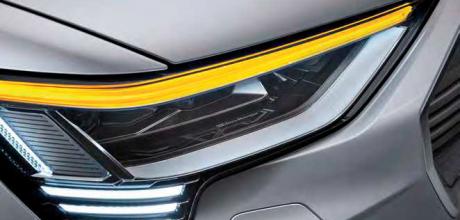What are the main in-car features that drain the battery pack of an electric car more quickly?
Energy is precious, and during an electric vehicle’s (EV) development, engineers fight to ensure as many amp hours as possible reach the tarmac to boost the car’s driving range. To do this, everything from the climate control to the car’s lighting needs to be as efficient as possible, to avoid draining the battery more quickly. So, what are the biggest battery consumers, and how can you eke more miles out of your EV?
“...PRE-CONDITION THE INTERIOR AND BATTERY BEFORE A TRIP STARTS...”
CURRENT AFFAIRS
Climate control
If you could minimise just one feature’s consumption, the car’s climate control and heating would be top of the list. While the effect won’t be so pronounced on a mild late spring day, if you hop in a freezing cold or boiling hot car and ask the car’s climate control system to condition the whole cabin to a pleasant 21 degrees, it’s likely to see your car’s predicted range tumble by around seven miles per hour of driving due to the significant energy required. In the worst-case scenario, this can use in excess of 5kW of energy, especially if the battery is also being heated to help it perform at its best.
The best way around this is to precondition the interior and battery before a trip starts – a feature most of the EVs on the market offer. This gently cools or heats the interior to your desired temperature while it’s still plugged in, using energy from the charger so it won’t affect the car’s range once you hop in, while also bringing the battery itself to the temperature where it’s most efficient. This can be controlled via the car’s companion smartphone app, or programmed in the car itself, which can work well if you have a regular commute at the same time most days. If you aren’t able to pre-condition the car, turn off unnecessary vents and try to keep the fan at a low speed. Some EVs have a ‘driver-only’ mode, which aims to just heat or cool the driver’s area of the car rather than the entire interior, while most EVs also have an ‘eco’ mode that runs the airconditioning compressor at a lower rate to save energy, or turns it off entirely. This is a good option, but you may need to turn eco mode off briefly to demist the windows.
Comfort features
High-end cars tend to be fitted with other heated elements such as a heated steering wheel, seats and sometimes even a heated windscreen. These consume around 100 to 150 watts of electricity each, so are best used for short periods of time for maximum efficiency. If it’s a cold day, turn on the heated seat and steering wheel for the first five minutes of the journey, but remember to turn them off again, especially on a long trip. There is an interesting side note here though – if it’s a reasonably mild day and the car hasn’t been preconditioned, leaving the car’s climate control switched off and just operating the driver’s heated seat to stay warm is likely to use less energy overall, so could be an option for the more hardy EV driver in need of maximum range.
Lighting
Virtually all electric cars make use of LED exterior and interior lighting, and not just because it looks cool. LEDs use far less energy than halogen bulbs, so even when driving at night with all your lights ablaze, the effect on an EV’s battery range should be minimal.
Audio and infotainment
The days of turning off the audio system to save energy seems to be over, too. In many cars, it’s not even possible to switch the system fully off, you’ll just mute the sound or dim the screen slightly. Luckily, modern infotainment systems are efficient, only using between 100 and 300 watts of power, with short spikes in their demands. Even a powerful speaker system will rarely operate in a way that requires lots of energy for more than a few milliseconds at a time.


